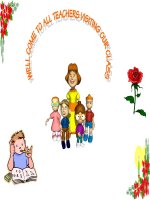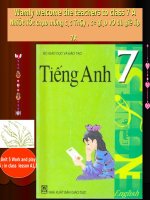Unit 5 Work and play
Bạn đang xem bản rút gọn của tài liệu. Xem và tải ngay bản đầy đủ của tài liệu tại đây (179.2 KB, 12 trang )
<span class='text_page_counter'>(1)</span>UNIT 5 : WORK AND PLAY Section A1 : IN CLASS I. Aims - Knowledge: introduce about the school topic in classes or at break. Through the period students can tell about subject in school. * Skills: Develop four skills. * Moral lesson: Ss should prepare your books well before going to school. II. Language focus 1. Vocabulary : use(v) computer science(n), map(n) be interested in do experiment learn about s.t (v) learn how to do s.t (v) 2. Grammar : What + do/ does + S + study in ………… ? What + be + S.O’s favorite class ? III. Teaching aids 1. Documents for teaching: Book, teacher’s book… 2. Method: Communicative method. 3. Teaching tool: Lesson plan, book, pictures, cassette, tape. IV. Teaching steps 1. Class procedures * Greetings * Checking attendance. Class Date Absent students Ss’ books 7A1 7A2 7A4 7A5 7A6 2. Cheking previous lesson Some students write the new words, read and give the meanings. Make new sentences:on the left/right, at the the back of, welcome, capital. T corrects if necessary and gives mark. 3. New lesson. Stages Warm up. Presentation. Teacher and students’ activities Content Make questions: -How many days a week do you go - six days to school? - at 7.00 -What time do classes start? - 12 -How many subjects do you learn? Now you listen to this passage and Unit 5: Work and play you will know how to answer these.
<span class='text_page_counter'>(2)</span> questions exactly and clearly Play the tape for the students. Have the students look at the pictures and read the captions under the each picture while listening the tape. Ask them to find the new words and explain these words and structures.. Practice. Production. Section A: In class 1. Listen and read 1.1 New words - learn about s.t (v) - learn how to do s.t (v) - use (v) - computer science(n) - be interested in (v). - Ss listen and guess meaning of the - map (n) - do experiment words . 1.2. Grammar - T reads the new words and Ss What + do / does + S + study repeat in chorus . in? - Individual What + be + Pos.adj+ favorite - Correct class? Ss listen the tape again & repeat Guiding Questions : the text in chorally . 1. What is Mai’s school’s - T aks Ss to answer guiding name? questions on the board . 2. Which grade is she in? - Ss answer them . 3. What time do her classes - Correct start/ finish ? Example - Ss practice the text. A:What does Mai study in her - Ss read the example . Geography class ? - T asks each student to make She studies maps and learns two Qs about Mai . about different countries . - Ss ask & answer the others with B:What is Mai’s favorite their partners . class? - Pairs of S ask & answer the Qs Her favorite class is aloud , some write the Qs & Computer Science . answers on the board . - T corrects. Can make some questions for students: Talk about you. -Which grade are you in? Work with a partner. -Do you go to school six days a week? -What do you think about your Then talk in front of the class. subjects? -What is your favorite class? Why? Listen and correct their mistakes if they have. 4. Homework and preparation : Students read the passages A1 again .Learn by heart new words and structures..
<span class='text_page_counter'>(3)</span> Then make new sentences again. Prepare A2, for the next period. 5. Experience: …………………………………………………………………….. Dak-o, October 16 th, 2016. (check and sign). Preparing date: October 20th, 2016.. Week:10 - Period: 28. UNIT 5 : WORK AND PLAY Section A2 : IN CLASS I. Aims - Knowledge:Through the period students can read and answer the questions about Ba. Practice the present simple tense with questions and answers about activities every day. * Skills: Develop four skills. * Moral lesson: Ss should prepare your books well before going to school. II. Language focus 1. Vocabulary Electronics (n) Household (n) Appliance (n) Draw (v) Drawing (n) Art club (n) Fix (v) = Repair (v) Enjoy (v) Good at (adj).
<span class='text_page_counter'>(4)</span> Dak-o secondary school. 2. Grammar (Be) good at + N/ V-ing III. Teaching aids 1. Documents for teaching: Book, teacher’s book… 2. Method: Communicative method. 3. Teaching tool: Lesson plan, book, pictures, cassette, tape. IV. Teaching steps 1. Class procedures * Greetings. * Checking attendance Class Date 7A1 7A2 7A4 7A5 7A6 2. Cheking previous lesson (No) 3.. Absent students. Ss’ books. New lesson. Stages Warm up 5 mins whole class. Presentation 15 mins. whole class. individual. Teacher and students’ activities T has Ss play game: Crosswords. “You say the subjects in these rows through looking at the pictures. Then who say the key in the red column first will receive a special gift” Ss play the game.. Content. * Row CHEMISTRY ENGLISH GEOGRAPHY PHYSICS MUSIC * Column: CLASS T has Ss look at the picture and leads UNIT 5 : WORK AND PLAY to the lesson. Section A : IN CLASS “This is Ba. What he is doing. What’s his favorite subject? To answer these 2. Read. Then answer the questions questions. we read a passage about Ba.” 2.1. New words T explains/lists new words and Electronics (n) structure. Household (n) Ss listen and repeat new words after Appliance (n) the teacher. Draw (v) T gets Ss repeat new words on the Drawing (n) board in individual. Art club (n) * T checks new words by asking the Fix (v) = Repair (v) meanings. Enjoy (v) Good at (adj) (Be) good at + N/ V-ing Eg: I am good at Math. P.4.
<span class='text_page_counter'>(5)</span> Dak-o secondary school. T reminds the questions with the present simple tense. Ss takes note and practice. individual T has Ss check true-False prediction. Ss gives their guess. T takes note. Practice 5 mins individual. T asks Ss listen to the tape twice. Ss listen carefully. T has Ss read the text silently. T invites 2 Ss to read the text aloud and then gives the answer for TrueFalse prediction. T supplies the key.. He is good at drawing. 2.2. Structures Which subject +do/does +S + like best? S +like(s)………..best. 2.3. True-False prediction 1. Ba enjoys school very much. 2. He likes Geography best. 3. He doesn’t learn to repair household appliances in Electronics. 4. He can fix the lights,the washing machine and the refrigerator. Key 1. T 2. F 3. F 4. T. 2.4. Answer the questions a. Ba/He likes electronics best. b. Yes, he does. He enjoys team work school very much. T asks Ss to read it in individually . c. He learns to repair house hold Ss read in silence & answer the appliances. questions. d. He can fix the lights, the Ss anwer the questions by playing washing machine and the Lucky number. refrigerator. T corrects and gives the keys. e. Yes, he is. His drawings are very good. Production f. What do you do in your free 5 mins time? T has the Ss work in pairs, ask and pair work I play soccer/ listen to music.... answer about yourself g. What are you good at? Ss make the questions for them. I am good at Math/ English/ .... Ss listen and correct their mistakes. h. What’s your favorite subject? T can ask the Ss to talk more about My favorite subject is Math/ their free time. English... T notes the main structures that you have just learnt. 4. Homework and preparation : Practice the passage A2 again. Learn by heart new words and structures. Prepare A4,5 for the next period . P.5.
<span class='text_page_counter'>(6)</span> Dak-o secondary school. 5. Experience:………………………………………………………………….. ……………………………………………………………… Preparing date: October 20th, 2016.. Week:10-Period:29. UNIT 5 : WORK AND PLAY Section A4,5: IN CLASS I. Aims - Knowledge: Consolidate the subjects, activities in the classes every day. Students learn the structures and new words to use math homework in English. * Skills: Develop four skills. * Moral lesson: Ss should study hard to hve good grades. II. Language focus 1. Vocabulary: (n): essay, past, present, event, language (Pre): Around, (adv): as well 2. Grammar: Present simple tense S + V / V -s/ -es III. Teaching aids 1. Documents for teaching: Book, teacher’s book… 2. Method: Communicative method. 3. Teaching tool: Lesson plan, book, pictures, cassette, tape. IV. Teaching steps 1. Class procedures * Greetings. * Checking attendance Class Date 7A1 7A2 7A4 7A5 7A6 2. Cheking previous lesson (No). Absent students. Ss’ books. New lesson. 3. Stages Warm up. Teacher and students’ activities T divides the class into two groups and Group A call 5 members of each group write about Subjects. The group writing Subjects more right words winner. Ss of group write the Subjects on the board. Correct.. Presentation T has Ss look at the pictures, elicits the names of the school subjects illustrated.. Content Group B. Unit 5 :Work and play Section A : In class (A4.5) 4. Listen. Then write the correct P.6.
<span class='text_page_counter'>(7)</span> Dak-o secondary school. T asks Ss some Qs to introduce the passage. Questions: 1. What are the pictures about? Can you guess what subjects Ba & Hoa learn on Saturday morning Practice. Summary. T asks Ss to listen & choose the subjects Ba & Hoa learn on Saturday morning. Ss listen once, not take notes. Ss listen the second time & match the letters of the pictures with Ba or Hoa .T checks the answers. Ss listen once again to check their answers. T asks Ss to tell some subjects they learn on a certain day. Ss talk about the subjects they learn on a certain day. **T asks some Qs to introduce the text Ss listen and answer T presents new words. Ss listen and guess meaning of the words. T reads the new words and Ss repeat in chorus. Individual Correct T read the text and Ss read the text chorally then individually. Ss practice asking & answering the Qs about the subjects mentioned in the text with their partner : Pairs of Ss ask & answer the Qs aloud What do you study in Literature? -What do you study in History? -What do you study in Geography? -What do you study in Physics? -Do you learn to play soccer in English?. letters next to the names (P54) Guess: They are about subjects such as Geography, Physical Education.... *Grammar: Present simple tense S + V / V s / es. Ba : d, e, a Hoa : c, b, e. 5. Read (P54) - essay (n) - past (n) - present (n) - event (n) - around (pre) - work (v) - language (n) - as well (adv). Answer the teacher’s question -We learn about books and write essay. -We study past and present. -We study different countries and their people. -We learn about how things work. Let students to look at Now discuss -No, we don’t. with a partner, and explain doing it: We have 4 names of subjects in Now discuss with a partner. Odd accordance with relevant words about one out (P55) each subject. You will find one Answer: irrelevant word and odd it out. - In literature, which word do you Have students work in small group add out? P.7.
<span class='text_page_counter'>(8)</span> Dak-o secondary school. Call groups to speak the keys. Give the correct keys:. - So, in which subject do we learn about paintings? Literature – paintings History -basket ball games Science – preposition English – England * Remember: S + be + good at + subject What + do / does + S + study in ………… ? What + be + S.O’s favorite class?. 4. Homework and preparation: - Students learn by heart new words and structures, practice from A4 to remember at home again. Prepare B1, two for the next period. 5. Experience: ……………………………………………………………………………………………………………… ………………………………………………………………………………………………………………. Preparing date: October 20th, 2016.. Week:10 - Period: 30. UNIT 5: WORK AND PLAY Section B1: IT’S TIME FOR RECESS I. Aims - Knowledge: Students can talk about & describe recess activities .Beside that students Can review the present progressive tense. * Skills: Develop four skills. * Moral lesson: Ss should prepare your books well before going to school. II. Language focus 1. Vocabulary: (N): recess, bell, blind man’s bluff, marble, catch (V): ring, chat, ring, (A): noisy, excited, (adv): indoors 2. Grammar: Present simple tense S + V / V-s / es…………….. Present progressive tense S + to be + V-ing…………… III. Teaching aids 1. Documents for teaching: Book, teacher’s book… 2. Method: Communicative method. 3. Teaching tool: Lesson plan, book, pictures, cassette, tape. IV. Teaching steps 1. Class procedures * Greetings. * Checking attendance P.8.
<span class='text_page_counter'>(9)</span> Dak-o secondary school. Class Date Absent students 7A1 7A2 7A4 7A5 7A6 2. Cheking previous lesson Check new words on the board: author, painting, basketball, game, famous people, world event, Pairs of students ask and answer the questions: What do you study in …?. Ss’ books. New lesson. 3. Stages Warm up. Teacherand students’ activities Make questions for students: What do you study in...? Are you good at...? What is your favorite subject? Do you like playing games? Which games do you like playing? When do you usually play it? Presentation Now you look at these pictures and speak what they are doing. Can you guess what games are they playing? (Can speak in Vietnamese) Introduce the new word use pictures in the textbook - Ss repeat in chorus - Individual Play the tape, and ask students to look at the book, read the passage Have them read passage aloud in front of the class. Check for pronunciation and make any necessary corrections. Have ss use each picture to make questions. Practice. - Ss practice the text. - T asks Ss to read the text in silence & each S makes three Qs about the people in the picture.. Content Sts’answers. Unit 5 :Work and play Section B : It’s time for recess ( B1,2 ) 1. Listen and read (p56) - recess (n) : - bell (n) : - ring (v) - into (pre) : - excited (a) : - as well as (adv) Ex : My father grows vegetables as well as flowers. - indoors (adv) - chat (v) : - blindman’s bluff (n) : - catch (n) - play marbles (v) - skip rope (v) What are these students doing at recess? They are playing games. -What are they playing? They are playing catch. a) Now work with a partner. Ask and answer the questions about the students in the picture (p57) A: What is this boy doing? B: He is playing catch. P.9.
<span class='text_page_counter'>(10)</span> Dak-o secondary school. Summary. - T asks Ss to read the example in pairs. - Ss practice it in pairs. - Ss ask & answer the Qs with their partners. - Pairs of S ask & answer the Qs aloud, some write the Qs & answers on the board. - T corrects. - Ss ask & answer the Qs about themselves.. b) Ask & answer Qs with a partner (p57) a) What do you usually do at recess? b) Do you usually talk with your friends? c) What do you usually do after school I…... Ss talk about their activities at recess T asks Ss to say the sentences they in pairs. have just listened to. - Ss talk about their activities at recess. - Correct 4. Homework and preparation Students learn by heart all structures and new words. Practice the entire lesson again. Prepare B3for the next period. 5. Experience …………………..……………………………………………………………………….. …………………………………………………………………………………………… Dak-o, October 23 rd, 2016. (check and sign). UNIT 5: WORK AND PLAY Section B2,3: IT’S TIME FOR RECESS I. Aims - Knowledge: Sts can know some activities at recess in American, then they compare with activities in Vietnamese. * Skills: Develop four skills. * Moral lesson: Ss should play sports after school. II. Language focus 1. Vocabulary pen-pal (n) junior high school(n) senior high school(n) score goal(n) earphone(n) worldwide(n) swap(v) energetic(a). P.10.
<span class='text_page_counter'>(11)</span> Dak-o secondary school. 2. Grammar What do you usually do at recess? III. Teaching aids 1. Documents for teaching: Book, teacher’s book… 2. Method: Communicative method. 3. Teaching tool: Lesson plan, book, pictures, cassette, tape. IV. Teaching steps 4. Class procedures * Greetings * Checking attendance. Class Date Absent students Ss’ books 7A1 7A2 7A4 7A5 7A6 5. Cheking previous lesson (No) 6. New lesson Stages Teacher and students’ activities Content Warm up T asks sts to answer the questions a) What do you often do at recess? Sts do. b) Which activities do you like best at recess? T: to know exactly what Mai, Kien, Lan, and Ba usually do at recess, let’s liten to the tape. Ss listen twice and give the answers. T has Ss listen again and check. T gives the key.. Presentation T asks Ss to anwer these questions. Ss anwer. To know exactly what American students usually do at recess, let’s readthe text in part 3 . T reads the text first then explains new words and structure. Sts listen and repeat new words after the teacher. Get individual Ss read new words on the board. T corrects if necessary.. Unit 5:Work and play Section B: It’s time for recess 2. Listen. Match each name to an Activity. Mai playing catch Kien playing marbles Lan skipping rope Ba playing blindman’s bluff KEY Mai playing catch Kien playing blindman’s bluff Lan skipping rope Ba playing marbles Questions a) What do Vietnamese students often do at recess? b) What do American S do at c) Recess? d) What activities do you like? 3. Read. Then answer the questions 3.1. New words Pen-pal (n) Junior high school (n) Senior high school (n) Score goal (n) Earphone (n) P.11.
<span class='text_page_counter'>(12)</span> Dak-o secondary school. Worldwide (n) Swap (v) Energetic (a) 3.2. Grammar S + V/ V-s /es What do you usually do at recess? I/We ………… Practice. T leads sts to read once. T asks Ss to answer guiding questions. Ss answer them. T corrects. T asks Ss to read the text silence & choose the best answer for each Q. Ss read in silence & choose the best answer for each Q. T checks the As.. Production Ss compare the recess activities in USA with the ones in VN in pairs. S talk about the same & differences of recess activities in two countries. a) What do American students do at recess? The energetic students often play basketball, many Ss listen to music, some of the children, mainly boy, swap baseball cards, they eat and talk with friends at recess. b) Which activities are the most common ways of relaxing at recess? Eating and talking are the most common ways of relaxing at recess. Answers a.C b. A c. D d.D * Ss compare the recess activities in USA with the ones in VN in pairs - Ss talk about the same & differences at recess activities in two countries. 4. Homework and preparation Students learn by heart some names of activities and the structures: simple present tense, present progressive tense. Prepare Unit 6 - part A1 for the next period. 5. Experience …………………..……………………………………………………………………….. ……………………………………………………………………………………………. P.12.
<span class='text_page_counter'>(13)</span>









